Lecce (Salentino: Lècce) is a city in the Apulia region of Italy.
Lecce has been dubbed "the Florence of the south". Whereas many people skip it in favour of the nearby beach towns of the Salento Peninsula, this city, distinguished by its elaborate style of baroque buildings, has at least a couple of days of attractions worth seeing.
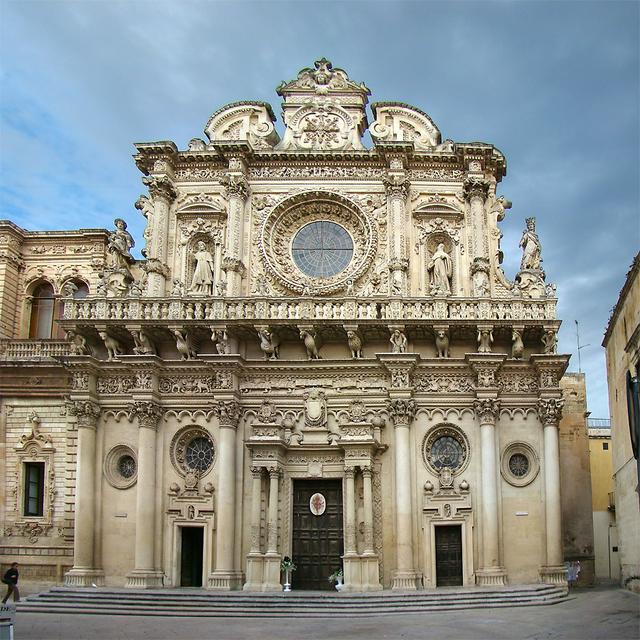 Lecce has more than 30 historic churches, these are the most representative ones:
Lecce has more than 30 historic churches, these are the most representative ones:
- Church of the Holy Cross, Via Umberto I, 3, +39 0832 241957. 09:00-12:00 and 17:00-20:00. It represents the main example of Lecce baroque style. It was built between 1549 and 1695, thanks to three well-known architects: Gabriele Riccardi, who devoted himself to the general plan and the lower part of the façade; Francesco Antonio Zimbalo who made the twin column porch and the portal aside; Cesare Penna who conceived the high level of the façade. The big Romanesque central rose window, the rich frame, the four columns, and the niches as well as the telamons, the imaginary creatures, the animals, the mythological and historical characters of the façade are all what makes this church unique and renowned over the world. free.
- Cathedral, Piazza del Duomo, +39 0832 308557. A wonderful example of baroque style, most of the cathedral was designed by Giuseppe Zimbalo and it was completed in 1689. free.
- Church of Saint Irene, Via Vittorio Emanuele II. A majestic baroque church with an elegant and quite sober exterior that hides a richly decorated interior. Free.
- Church of Saint John the Baptist, Via Giuseppe Libertini, 5, +39 0832 308540. A magnificent façade characterised by two grooved columns, completed in 1728. It is just few steps away from Porta Rudiae. Free.
- Church of Santa Chiara, Piazzetta Vittorio Emanuele II, +39 0832 241915. Built in 1429 and renovated in 1691, its main features are the octagonal interior plan and the lavish altars. Free.
Church of the Holy Cross, Via Umberto I, 3, +39 0832 241957. 09:00-12:00 and 17:00-20:00. It represents the main example of Lecce baroque style. It was built between 1549 and 1695, thanks to three well-known architects: Gabriele Riccardi, who devoted himself to the general plan and the lower part of the façade; Francesco Antonio Zimbalo who made the twin column porch and the portal aside; Cesare Penna who conceived the high level of the façade. The big Romanesque central rose window, the rich frame, the four columns, and the niches as well as the telamons, the imaginary creatures, the animals, the mythological and historical characters of the façade are all what makes this church unique and renowned over the world. free.
Cathedral, Piazza del Duomo, +39 0832 308557. A wonderful example of baroque style, most of the cathedral was designed by Giuseppe Zimbalo and it was completed in 1689. free.
Church of Saint Irene, Via Vittorio Emanuele II. A majestic baroque church with an elegant and quite sober exterior that hides a richly decorated interior. Free.
Church of Saint John the Baptist, Via Giuseppe Libertini, 5, +39 0832 308540. A magnificent façade characterised by two grooved columns, completed in 1728. It is just few steps away from Porta Rudiae. Free.
Church of Santa Chiara, Piazzetta Vittorio Emanuele II, +39 0832 241915. Built in 1429 and renovated in 1691, its main features are the octagonal interior plan and the lavish altars. Free.
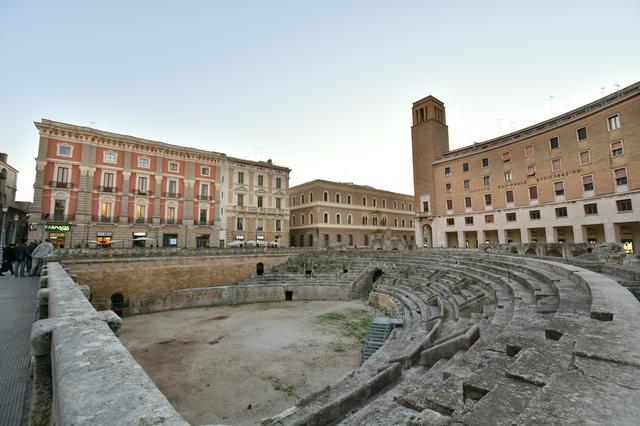
- Roman amphitheatre, Piazza Sant'Oronzo, 42, +39 0832 253791. The structure was built during the 2nd century AD and it was able to seat more than 25,000 people. It is used for various religious, music and art events. Adults €3.00; groups €1.50; students €1.00.
- Roman theatre, Via Arte della Cartapesta, 10, +39 0832 682985. In the heart of the old town, it was built in the 1st century AD and it had a capacity of 5,000 people. It is now seat of events and performances.
- Rudiae archaeological park, Via S. Pietro in Lama. Site of an ancient Messapian and then Roman town, 3 km south from the city center. Here you can see the remains of the amphitheatre, a necropolis and walls.
Roman amphitheatre, Piazza Sant'Oronzo, 42, +39 0832 253791. The structure was built during the 2nd century AD and it was able to seat more than 25,000 people. It is used for various religious, music and art events. Adults €3.00; groups €1.50; students €1.00.
Roman theatre, Via Arte della Cartapesta, 10, +39 0832 682985. In the heart of the old town, it was built in the 1st century AD and it had a capacity of 5,000 people. It is now seat of events and performances.
Rudiae archaeological park, Via S. Pietro in Lama. Site of an ancient Messapian and then Roman town, 3 km south from the city center. Here you can see the remains of the amphitheatre, a necropolis and walls.
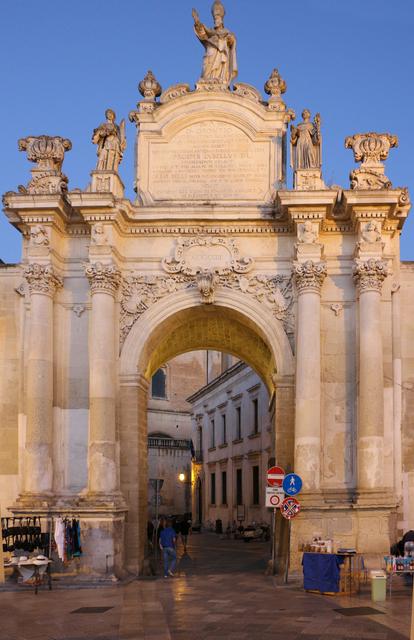
- Piazza S. Oronzo - It's in the heart of the city and named after the patron saint's statue erected in 1666 after the population had defeated the plague which had broken out ten years before.
- Paisiello Theatre - Once the permanent theatre of the town. Founded in 1758 and rebuilt in 1870, it was opened with the performance of Giuseppe Verdi' s 'Un ballo in maschera". Because of its rich decorations, this theatre - which can only contain 320 spectators - is nicknamed "The wedding souvenir".
- Castle of Charles V. A majestic medieval castle rebuilt during the first half of XVI century. It is seat of several exhibitions, events and conferences.
- Triumphal Arch, Piazzetta Arco di Trionfo. It was erected in 1548 to pay homage to Charles V and thank him for having fortified the town. It is known as "Neapolitan Gate" since there started the road leading to Naples, capital of the kingdom.
- Porta Rudiae. The oldest gate of the town, rebuilt in 1703 in baroque style.
- Porta San Biagio, Piazza d'Italia, 8. The southern entrance to the old town, dedicated to Saint Blaise. It is 17 m (55 ft) tall and it's topped by the coat of arms of Ferdinand I of the Two Sicilies.
- Park Tower, Viale Torre del Parco, 1, +39 0832 347694. A fortress symbol of Lecce's medieval period, built in 1419. It is now seat of meetings, weddings, cultural events and a 4-star hotel.
- Obelisk, Piazzetta Arco di Trionfo (In front of Porta Napoli. 10 meters (33 ft) high structure built in 1822 in honour of king Ferdinand I of the Two Sicilies.
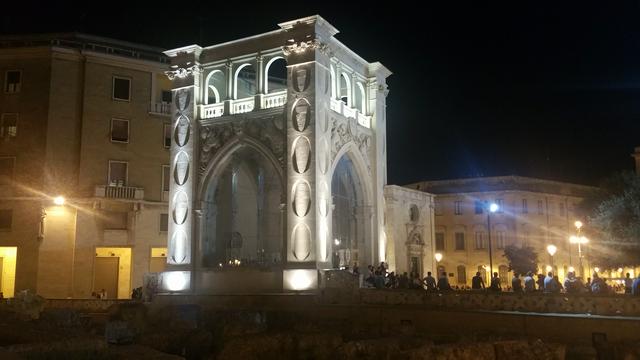
- Palazzo dei Celestini, Via Umberto I, 13 (beside Basilica di Santa Croce, +39 0832 332463. The seat of Province of Lecce in an impressive baroque building completed in 1695
- Palazzo del Seggio, Piazza Sant'Oronzo, +39 0832 682102. 09:30-13:30 and 15:30-19:30. Ancient city hall, it represents an interesting mixture of gothic and renaissance architecture.It is situated in the middle of the vibrant Piazza S.Oronzo, contiguous with the small Church of San Marco. Free.
Piazza S. Oronzo - It's in the heart of the city and named after the patron saint's statue erected in 1666 after the population had defeated the plague which had broken out ten years before.
Paisiello Theatre - Once the permanent theatre of the town. Founded in 1758 and rebuilt in 1870, it was opened with the performance of Giuseppe Verdi' s 'Un ballo in maschera". Because of its rich decorations, this theatre - which can only contain 320 spectators - is nicknamed "The wedding souvenir".
Castle of Charles V. A majestic medieval castle rebuilt during the first half of XVI century. It is seat of several exhibitions, events and conferences.
Triumphal Arch, Piazzetta Arco di Trionfo. It was erected in 1548 to pay homage to Charles V and thank him for having fortified the town. It is known as "Neapolitan Gate" since there started the road leading to Naples, capital of the kingdom.
Porta Rudiae. The oldest gate of the town, rebuilt in 1703 in baroque style.
Porta San Biagio, Piazza d'Italia, 8. The southern entrance to the old town, dedicated to Saint Blaise. It is 17 m (55 ft) tall and it's topped by the coat of arms of Ferdinand I of the Two Sicilies.
Park Tower, Viale Torre del Parco, 1, +39 0832 347694. A fortress symbol of Lecce's medieval period, built in 1419. It is now seat of meetings, weddings, cultural events and a 4-star hotel.
Obelisk, Piazzetta Arco di Trionfo (In front of Porta Napoli. 10 meters (33 ft) high structure built in 1822 in honour of king Ferdinand I of the Two Sicilies.
Palazzo dei Celestini, Via Umberto I, 13 (beside Basilica di Santa Croce, +39 0832 332463. The seat of Province of Lecce in an impressive baroque building completed in 1695
Palazzo del Seggio, Piazza Sant'Oronzo, +39 0832 682102. 09:30-13:30 and 15:30-19:30. Ancient city hall, it represents an interesting mixture of gothic and renaissance architecture.It is situated in the middle of the vibrant Piazza S.Oronzo, contiguous with the small Church of San Marco. Free.
- Lecce cake
- fantastic gelato from Gelateria Natale in the old city.
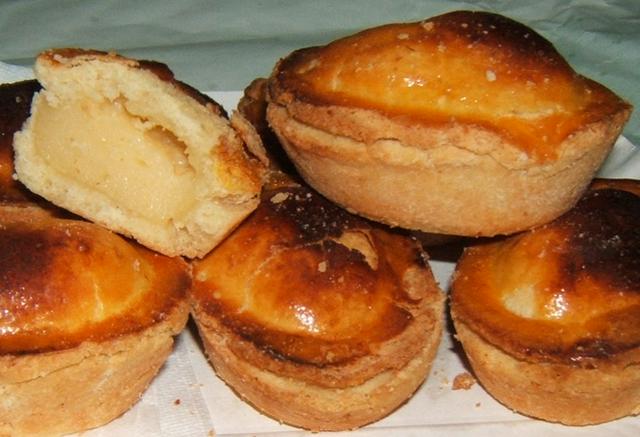 Pasticciotto Leccese is the typical cake of the town. It is made of shortcrust pastry filled with custard and by tradition it must be eaten warm as a breakfast item.
Pasticciotto Leccese is the typical cake of the town. It is made of shortcrust pastry filled with custard and by tradition it must be eaten warm as a breakfast item.
- Martinucci Laboratory, Via Salvatore Trinchese 7, +39 0832 309535. 09:00-01:30. Taste the delicious cakes and ice creams of the most famous ice-cream franchise of Salento.
- Joyce Vineria/Enoteca, Via Umberto I, 4, Lecce, Tel. +39 0832 279443
- Delicious "cucina tipica" food served with aplomb in a small restaurant in the old city. Many inventive and interesting recipes, plus a large and relatively inexpensive selection of regional and national wines. A terrific choice in the old city, where many restaurants are aimed at tourists and are of limited quality.
- Tabisca, Vico dietro lo Spedale dei Pellegrini 29 (an alley near Piazzetta Santa Chiara, +39 0832 243192. Daily 18:30-01:00. Mediterranean cuisine with a large choice of wine in the earth of the old city.
Martinucci Laboratory, Via Salvatore Trinchese 7, +39 0832 309535. 09:00-01:30. Taste the delicious cakes and ice creams of the most famous ice-cream franchise of Salento.
Tabisca, Vico dietro lo Spedale dei Pellegrini 29 (an alley near Piazzetta Santa Chiara, +39 0832 243192. Daily 18:30-01:00. Mediterranean cuisine with a large choice of wine in the earth of the old city.
Nearby Lecce are the following towns:
- Otranto
- Monopoli
- Gallipoli
- Santa Maria di Leuca
- Specchia Other popular destinations such as Alberobello and Matera are also easily reachable by car. Consider spending at least on day at each, but if you're too short on time it is possible to see the main attractions of both in a day trip from Lecce.
